(复杂系统的性能评价与优化课件资料)overview_lecture
- 格式:ppt
- 大小:1.38 MB
- 文档页数:47
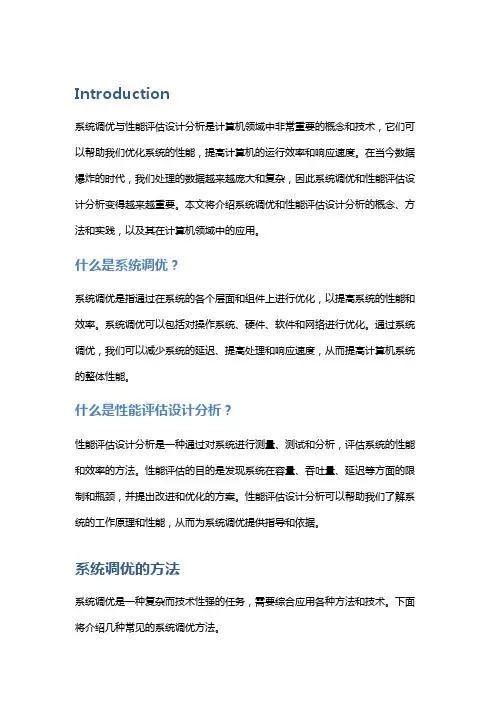
Introduction系统调优与性能评估设计分析是计算机领域中非常重要的概念和技术,它们可以帮助我们优化系统的性能,提高计算机的运行效率和响应速度。
在当今数据爆炸的时代,我们处理的数据越来越庞大和复杂,因此系统调优和性能评估设计分析变得越来越重要。
本文将介绍系统调优和性能评估设计分析的概念、方法和实践,以及其在计算机领域中的应用。
什么是系统调优?系统调优是指通过在系统的各个层面和组件上进行优化,以提高系统的性能和效率。
系统调优可以包括对操作系统、硬件、软件和网络进行优化。
通过系统调优,我们可以减少系统的延迟、提高处理和响应速度,从而提高计算机系统的整体性能。
什么是性能评估设计分析?性能评估设计分析是一种通过对系统进行测量、测试和分析,评估系统的性能和效率的方法。
性能评估的目的是发现系统在容量、吞吐量、延迟等方面的限制和瓶颈,并提出改进和优化的方案。
性能评估设计分析可以帮助我们了解系统的工作原理和性能,从而为系统调优提供指导和依据。
系统调优的方法系统调优是一种复杂而技术性强的任务,需要综合应用各种方法和技术。
下面将介绍几种常见的系统调优方法。
测量和监测测量和监测是系统调优的关键步骤之一,它可以帮助我们了解系统的当前状态和性能瓶颈。
通过测量和监测,我们可以获取系统的各种指标和度量,如延迟、吞吐量、资源利用率等。
这些数据可以用于分析系统的性能问题和优化需求。
性能剖析性能剖析是一种通过对系统的运行进行分析和调查,识别性能瓶颈和瓶颈的部分进行系统调优的方法。
通过性能剖析,我们可以找到系统中的瓶颈和效率低下的部分,并提出相应的优化方案。
性能剖析可以帮助我们深入了解系统的工作原理和性能瓶颈,从而提高系统的性能。
优化算法和数据结构优化算法和数据结构是系统调优中一个非常重要的方面。
通过优化算法和数据结构,我们可以改进系统的算法和数据结构,以提高系统的性能和效率。
例如,通过使用更高效的排序算法或数据结构,我们可以减少系统的延迟和提高处理速度。
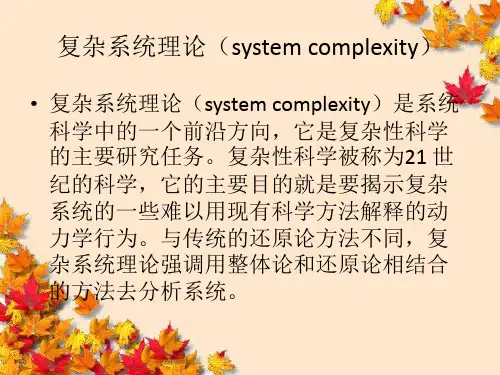

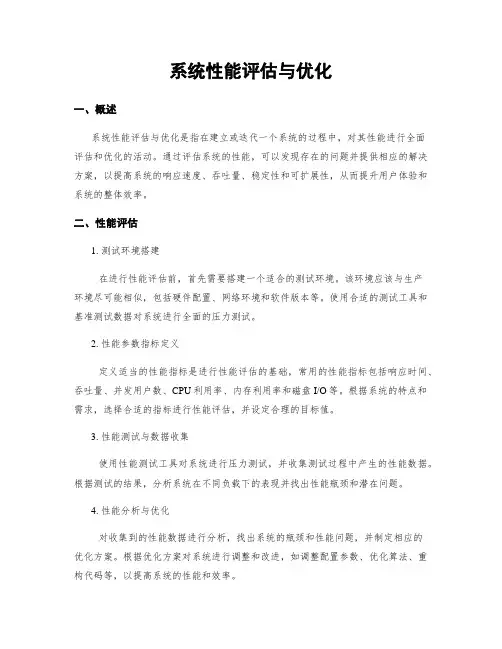
系统性能评估与优化一、概述系统性能评估与优化是指在建立或迭代一个系统的过程中,对其性能进行全面评估和优化的活动。
通过评估系统的性能,可以发现存在的问题并提供相应的解决方案,以提高系统的响应速度、吞吐量、稳定性和可扩展性,从而提升用户体验和系统的整体效率。
二、性能评估1. 测试环境搭建在进行性能评估前,首先需要搭建一个适合的测试环境。
该环境应该与生产环境尽可能相似,包括硬件配置、网络环境和软件版本等。
使用合适的测试工具和基准测试数据对系统进行全面的压力测试。
2. 性能参数指标定义定义适当的性能指标是进行性能评估的基础,常用的性能指标包括响应时间、吞吐量、并发用户数、CPU利用率、内存利用率和磁盘I/O等。
根据系统的特点和需求,选择合适的指标进行性能评估,并设定合理的目标值。
3. 性能测试与数据收集使用性能测试工具对系统进行压力测试,并收集测试过程中产生的性能数据。
根据测试的结果,分析系统在不同负载下的表现并找出性能瓶颈和潜在问题。
4. 性能分析与优化对收集到的性能数据进行分析,找出系统的瓶颈和性能问题,并制定相应的优化方案。
根据优化方案对系统进行调整和改进,如调整配置参数、优化算法、重构代码等,以提高系统的性能和效率。
三、性能优化1. 代码优化对系统的代码进行优化,包括提高代码逻辑的简洁性和清晰性、减少冗余计算和数据访问、合理使用数据结构和算法等。
通过代码优化,可以显著提升系统的执行效率和响应速度。
2. 数据库优化对系统中频繁使用的数据库进行优化,包括索引的合理设计、SQL语句的优化、批量操作的使用等。
通过优化数据库的访问方式和数据存储结构,可以显著提高系统的数据库操作性能和响应速度。
3. 缓存优化合理使用缓存技术,如页面缓存、对象缓存和查询结果缓存等,减少对后端服务的访问频率和响应时间。
通过缓存优化,可以大大提高系统的响应速度和并发性能。
4. 并发与负载均衡优化根据系统的负载特点和需求,合理调整并发线程数、连接池大小和服务器集群配置,以实现负载均衡和资源的合理分配。


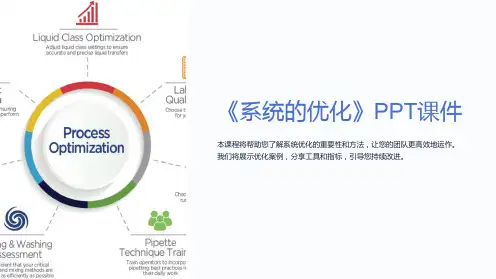
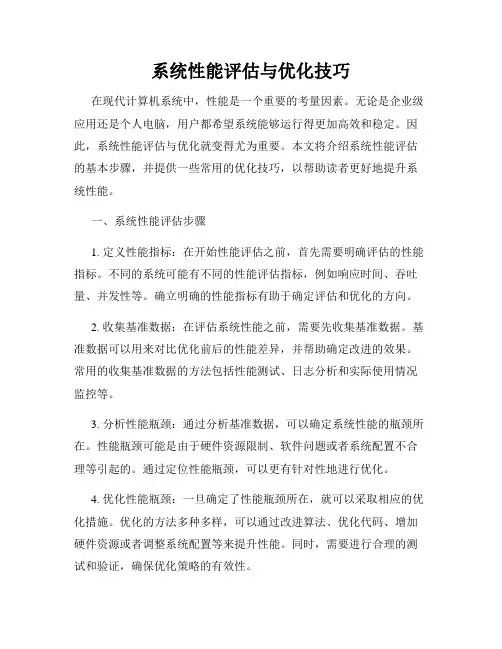
系统性能评估与优化技巧在现代计算机系统中,性能是一个重要的考量因素。
无论是企业级应用还是个人电脑,用户都希望系统能够运行得更加高效和稳定。
因此,系统性能评估与优化就变得尤为重要。
本文将介绍系统性能评估的基本步骤,并提供一些常用的优化技巧,以帮助读者更好地提升系统性能。
一、系统性能评估步骤1. 定义性能指标:在开始性能评估之前,首先需要明确评估的性能指标。
不同的系统可能有不同的性能评估指标,例如响应时间、吞吐量、并发性等。
确立明确的性能指标有助于确定评估和优化的方向。
2. 收集基准数据:在评估系统性能之前,需要先收集基准数据。
基准数据可以用来对比优化前后的性能差异,并帮助确定改进的效果。
常用的收集基准数据的方法包括性能测试、日志分析和实际使用情况监控等。
3. 分析性能瓶颈:通过分析基准数据,可以确定系统性能的瓶颈所在。
性能瓶颈可能是由于硬件资源限制、软件问题或者系统配置不合理等引起的。
通过定位性能瓶颈,可以更有针对性地进行优化。
4. 优化性能瓶颈:一旦确定了性能瓶颈所在,就可以采取相应的优化措施。
优化的方法多种多样,可以通过改进算法、优化代码、增加硬件资源或者调整系统配置等来提升性能。
同时,需要进行合理的测试和验证,确保优化策略的有效性。
二、系统性能优化技巧1. 程序设计优化:优化程序设计是提升系统性能的重要手段。
在设计过程中,可以采用高效的算法和数据结构,减少冗余的计算,避免频繁的I/O操作,以及合理使用缓存等技巧。
此外,对于大规模数据处理任务,可以考虑并行计算和分布式计算等方式来提高效率。
2. 资源管理优化:充分利用硬件资源是提升系统性能的一个关键方面。
在多核处理器环境下,可以通过线程池和任务队列等方式充分利用多核计算能力。
此外,有效管理内存、磁盘和网络资源,避免资源的浪费和瓶颈是提升性能的核心问题。
3. 系统调优:系统配置的合理优化也是提升性能的一个重要环节。
通过调整操作系统参数、网络设置和文件系统的配置等,可以改善程序的运行效率。

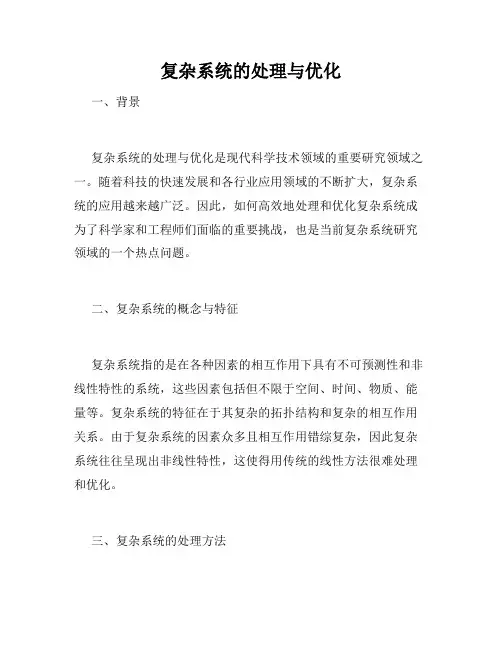
复杂系统的处理与优化一、背景复杂系统的处理与优化是现代科学技术领域的重要研究领域之一。
随着科技的快速发展和各行业应用领域的不断扩大,复杂系统的应用越来越广泛。
因此,如何高效地处理和优化复杂系统成为了科学家和工程师们面临的重要挑战,也是当前复杂系统研究领域的一个热点问题。
二、复杂系统的概念与特征复杂系统指的是在各种因素的相互作用下具有不可预测性和非线性特性的系统,这些因素包括但不限于空间、时间、物质、能量等。
复杂系统的特征在于其复杂的拓扑结构和复杂的相互作用关系。
由于复杂系统的因素众多且相互作用错综复杂,因此复杂系统往往呈现出非线性特性,这使得用传统的线性方法很难处理和优化。
三、复杂系统的处理方法针对复杂系统的特点,研究人员提出了多种处理方法,下面介绍其中的几种:1.模型建立模型建立是处理复杂系统的基础。
模型可以描述系统中各种因素的相互作用及其互相影响的情况,为复杂系统的优化提供必要的理论基础。
模型可以基于基本物理定律、经验规律,也可以基于统计学方法和数学建模方法。
研究人员可以通过实验和数据分析来建立模型,以便对复杂系统进行更加准确和有效的处理和优化。
2.数据挖掘数据挖掘是从大量数据中发现规律性的方法。
复杂系统的原始数据量往往非常大,通过数据挖掘可以从中发现有价值的信息,为复杂系统的处理提供支持。
数据挖掘方法包括聚类分析、关联分析、分类分析等。
这些方法能够对复杂系统数据进行有意义的分类、关联和分析,从而为解决复杂问题提供基础。
3.网络分析网络分析是处理和优化复杂系统的有效方法之一。
网络分析可以将复杂系统转化成网络结构,从而研究其节点和边的相互作用关系。
网络分析方法包括社会网络分析、复杂网络分析等。
这些方法能够揭示复杂系统的结构和演化规律,并且为复杂系统的优化提供基础。
四、复杂系统的优化方法为了进一步提高复杂系统的效率和性能,研究人员提出了各种优化方法。
1.模拟退火算法模拟退火算法是一种基于概率的优化方法,通常用于处理复杂问题。
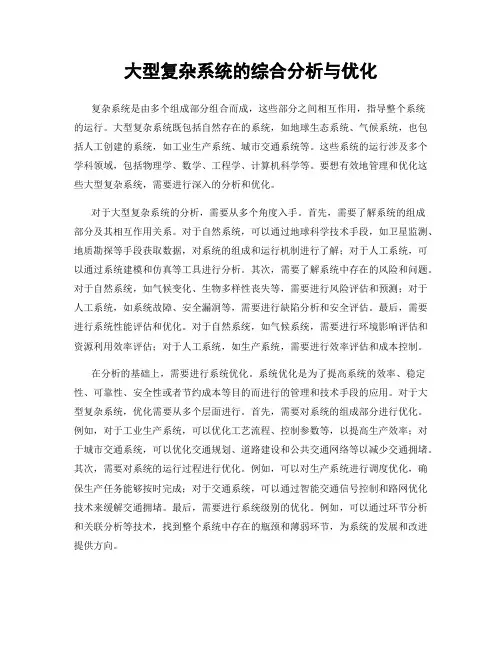
大型复杂系统的综合分析与优化复杂系统是由多个组成部分组合而成,这些部分之间相互作用,指导整个系统的运行。
大型复杂系统既包括自然存在的系统,如地球生态系统、气候系统,也包括人工创建的系统,如工业生产系统、城市交通系统等。
这些系统的运行涉及多个学科领域,包括物理学、数学、工程学、计算机科学等。
要想有效地管理和优化这些大型复杂系统,需要进行深入的分析和优化。
对于大型复杂系统的分析,需要从多个角度入手。
首先,需要了解系统的组成部分及其相互作用关系。
对于自然系统,可以通过地球科学技术手段,如卫星监测、地质勘探等手段获取数据,对系统的组成和运行机制进行了解;对于人工系统,可以通过系统建模和仿真等工具进行分析。
其次,需要了解系统中存在的风险和问题。
对于自然系统,如气候变化、生物多样性丧失等,需要进行风险评估和预测;对于人工系统,如系统故障、安全漏洞等,需要进行缺陷分析和安全评估。
最后,需要进行系统性能评估和优化。
对于自然系统,如气候系统,需要进行环境影响评估和资源利用效率评估;对于人工系统,如生产系统,需要进行效率评估和成本控制。
在分析的基础上,需要进行系统优化。
系统优化是为了提高系统的效率、稳定性、可靠性、安全性或者节约成本等目的而进行的管理和技术手段的应用。
对于大型复杂系统,优化需要从多个层面进行。
首先,需要对系统的组成部分进行优化。
例如,对于工业生产系统,可以优化工艺流程、控制参数等,以提高生产效率;对于城市交通系统,可以优化交通规划、道路建设和公共交通网络等以减少交通拥堵。
其次,需要对系统的运行过程进行优化。
例如,可以对生产系统进行调度优化,确保生产任务能够按时完成;对于交通系统,可以通过智能交通信号控制和路网优化技术来缓解交通拥堵。
最后,需要进行系统级别的优化。
例如,可以通过环节分析和关联分析等技术,找到整个系统中存在的瓶颈和薄弱环节,为系统的发展和改进提供方向。
综合分析和优化是大型复杂系统管理的核心内容。
系统性能评估与优化:如何评估系统性能,找出系统瓶颈并进行优化引言当我们使用计算机系统进行各种任务时,系统性能是至关重要的。
无论是进行科学计算、玩游戏还是进行日常办公,我们都希望系统能够以高效、快速、可靠的方式完成任务。
然而,系统的性能受到多种因素的影响,包括硬件配置、软件设计、网络连接等等。
因此,对系统性能进行全面评估和优化是非常必要的。
本文将介绍如何评估系统性能,找出系统瓶颈并进行系统性能优化。
我们将从初步评估开始,逐步深入,探讨各种评估和优化方法。
通过了解系统性能评估与优化的基本原理和方法,我们将能够更好地理解和处理系统性能问题。
初步评估要评估系统的性能,首先需要对系统进行初步评估。
这个评估过程可以简单地观察系统在正常使用情况下的表现,包括响应速度、运行稳定性等方面。
虽然这种评估方法并不精确,但可以帮助我们初步了解系统的性能。
观察响应速度观察系统的响应速度是初步评估系统性能的一种简单有效的方法。
我们可以观察系统在各种不同任务下的响应速度,比较其快慢。
一般来说,如果系统的响应速度较快,那么系统的性能可能较好;反之,如果系统响应速度较慢,可能存在性能问题。
运行稳定性评估除了观察响应速度,我们还可以评估系统的运行稳定性。
运行稳定性是指系统能够持续稳定运行的能力。
我们可以观察系统在长时间运行时是否存在崩溃、卡顿等问题。
如果系统经常出现这些问题,那么可能存在性能问题。
性能评估方法初步评估只能提供一些主观的参考,为了更准确地评估系统性能,我们需要使用一些科学的方法和工具。
下面将介绍几种常用的系统性能评估方法。
负载测试负载测试是评估系统性能的一种常用方法。
在负载测试中,我们会模拟系统在不同负载情况下的工作状态,观察系统对负载的响应能力。
常用的负载测试工具包括Apache JMeter、LoadRunner等。
通过负载测试,我们可以得到系统在不同负载情况下的性能指标,如响应时间、吞吐量等,从而评估系统的性能。